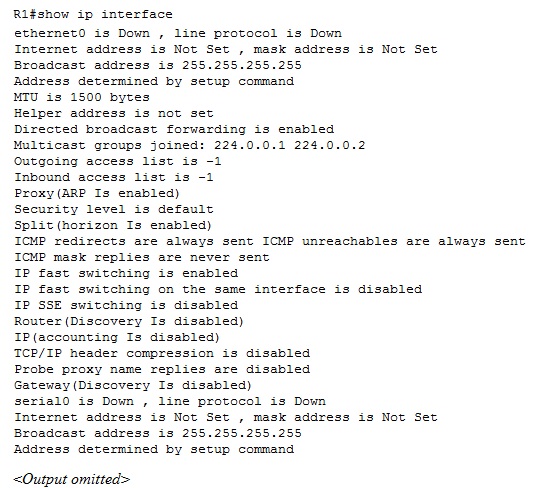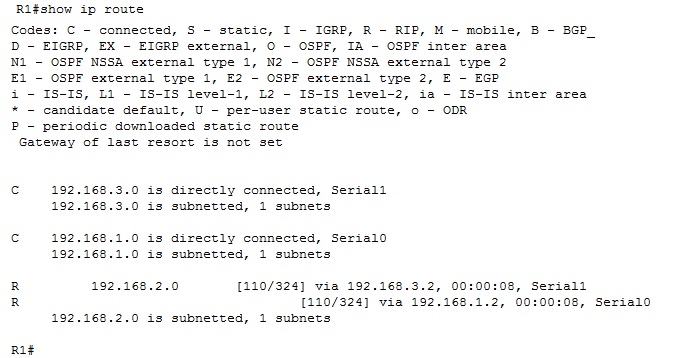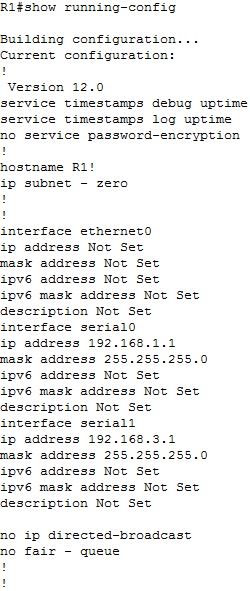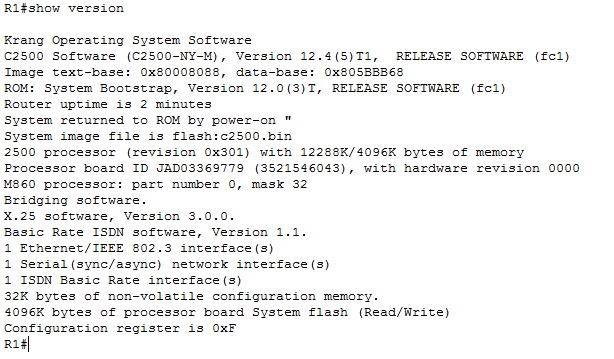RETIRED! Exam
Show command is extensively used for seeing the status and configuration information of the router. Some of the frequently used commands are:
Show IP protocol: This command will show information on RIP timers including routing update timer (30sec default), hold-down timer (default 180sec). It also displays the number of seconds due for next update (this is fraction of update timer). This command also gives the network number for which IP RIP is enabled, Gateway, and the default metric
following is the output from the "show ip protocol" command

In the above output routing protocol defined is RIP and two network defined are 192.168.1.0 and 192.168.3.0
Show IP interface: This command shows you interface-wise information such as IP address assigned to each interface, whether the interface is up, MTU etc.

Show IP route: This command will display the IP routing table entries. In addition, it displays the Gateway of last resort (if one is assigned). It also displays the codes used for various types of routes.
following is the output from the "show ip route" command

Some of the important codes are:
C: directly connected;
S: Statically connected
E : EIGRP
R : RIP
Debug IP RIP: Debug IP RIP will turn the RIP debugging ON. This will display a continuous list of routing updates as they are sent and received. This leads to lot of overhead, which is the reason that you use "undebug ip rip" to turn-off debugging as soon as you finish with debugging.

show interface trunk: This command determines the trunking status of a link and VLAN status. This command lists port, its mode, encapsulation and whether it is trunking enabled.

Show running-configuration - This command displays the router's active configuration file, passwords, system name, and interface settings, interfaces IP addresses etc.

show interfaces - Displays statistics for all interfaces configured on the switch
show interface <interface_no> : is a very usefull command. It displays the following information:
1. Hardware address
2. Status of interface and the line protocol - carrier detect brings up the serial port(which means that physical layer connections are working) and keep alive bring up the line protocol (which means that Data link layer protocol is working).
3. MTU, BW, DLY, rely, and load metrics.
4. Encapsulation type (layer 2, Data link layer) - HDLC is the default.
Ex : show interface serial 0 - Shows the serial 0 configuration.
Below is command output from "show interface serial 0"

show process - Displays a router's CPU utilization.
sh hosts - displays the host names and related IP addresses. That is to verify that the entry is stored in the router's host table.

show ip interface brief : Use the command "show ip interface brief" to check the status of all the interfaces. Turn on the interface which is administratively down and correct the issue. The output of "show ip interface brief" is as shown below

Interface : Name of the interface
Ip address - IP address assigned to the interface
status - defines the interface up or down
protocol - defines the interface up or down
show version - Displays information about the system hardware (RAM/ROM), software version, names of configuration files, and boot-images. This command will also show the current configuration register value.
Show version command displays the current version of the Cisco IOS. In addition, this command displays the following important information:
Below is the output from "show version" command

show controllers serial [port number] : to see if the interface detects a DCE or DTE cable.
By default, an interface will be in shut-down state. We need to issue no shutdown command to bring-up the interface
The command syntax is
R1>enable
R1#configure terminal
R1(config)#interface serial 0
R1(config-if)#no shutdown
127.0.0.1 is the local loopback address defined by the Internet Protocol and used for by a host to ping itself to verify the IP connectivity.
By default, the keepalive time interval is 10 seconds on Cisco serial interfaces. The keepalive interval can be changed with the keepalive interface configuration command.
R1>enable
R1#configure terminal
enter into global configuration mode
R1(config)#interface serial 0
R1(config-if)#keepalive 15
You can see the keepalive timer using show interface commands. If the the keepalive timers are not configured properly, it may result in intermittent or no communication in a network (such as Frame Relay) due to sync problems.
a. The command "ip address <ipadd> <maskadd>" is to be given in the interface configuration mode to configure ip address of a device
b. The command "no shutdown" enables an interface. By default, Cisco router interfaces are in shutdown state. Therefore, one needs to issue "no shutdown" command to bring up the interface.
c. The command "description" is be used to label an interface.
The hostname command is used to configure a device hostname. Because this command changes a device configuration, the command must be entered in the global configuration mode. After typing the command the prompt changes and displays the new hostname.
First, enter the global configuration mode by typing the enable command in the user EXEC mode and the configuration terminal command in the privileged EXEC mode. Once inside the global configuration mode, type the command hostname Cisco. Here is an example that shows you how to change a hostname of a device. Notice how the prompt was changed to reflect the configured value.
R1>enable
R1#configure terminal
R1(config)#hostname Myrouter
Myrouter(config)#
The banner is displayed whenever anyone logs in to your Cisco router. The syntax is "banner motd # " : MOTD stands for "Message Of The Day". # symbol signifies the start of the banner message to the router. You will be prompted for the message to be displayed. You need to enter "#" symbol at the end of the message, signifying that the msg has ended.

